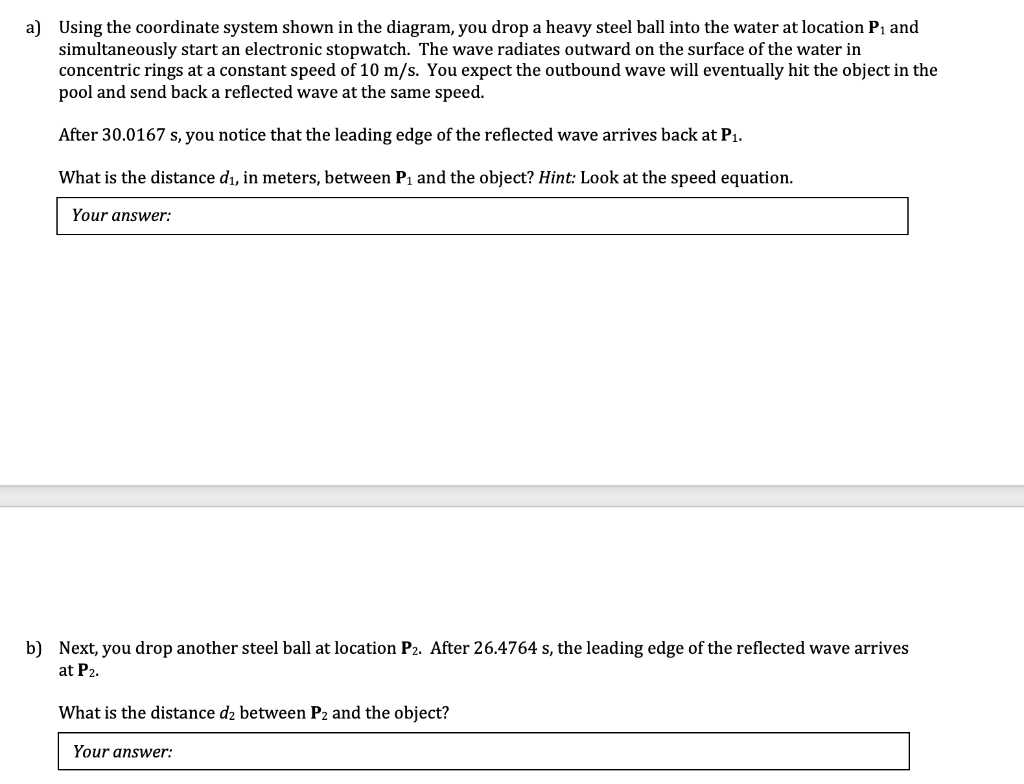


 Please answer all questions I will do anything that helps. I will rate. Thank you
Please answer all questions I will do anything that helps. I will rate. Thank you
. 1. Write a Python script that performs the actual calculations and displays the results as you make progress through each part of the problem. In your script, place a comment line before each section that states which part that section is solving, e.g., # Part (a). Try to follow good programming practices in your code. 2. Write your calculated answers in the boxes below. Round off numbers to two decimal places. . h C distance Useful equations: speed = Law of cosines c2 = a2 + b2 2abcos (0) 0 time a Physical Layout Suppose there is a square-shaped pool filled with water (Figure 2.1). Both the length and width of the pool are 1000 m. The water has a uniform depth of 10 m. There is a small, non-moving, transparent object in the water near the surface of the pool. The object cannot be seen, and you are trying to locate it. The object acts as a perfect reflector of surface water waves (Figure 2.2). (0, 1000) P3 Outbound wave from dropped ball P1 : P2 Object Reflected wave from object P1 = (500 m, 500 m) P2 = (600 m, 500 m) P3 = (500 m, 700 m) (1000, 0) (0,0) Figure 2.2 a) Using the coordinate system shown in the diagram, you drop a heavy steel ball into the water at location P1 and simultaneously start an electronic stopwatch. The wave radiates outward on the surface of the water in concentric rings at a constant speed of 10 m/s. You expect the outbound wave will eventually hit the object in the pool and send back a reflected wave at the same speed. After 30.0167 s, you notice that the leading edge of the reflected wave arrives back at P1. What is the distance d1, in meters, between P, and the object? Hint: Look at the speed equation. Your answer: b) Next, you drop another steel ball at location P2. After 26.4764 s, the leading edge of the reflected wave arrives at P2. What is the distance d2 between P2 and the object? Your answer: c) In Part (a), the distance di from P1 to the unknown object was determined strictly from a time measurement, which does not provide specific information about direction. All you can say is that the object lies somewhere on the boundary of a circle that is centered about P1 and has a radius d. The location P2 would have its own center and a radius d2. From these two circles, you could look to see where they intersect each other, which would give you a clue about where the object could be. a In general, suppose you have a circle in a 2-D plane. The circle's center has coordinates (Cox Cy) and the radius is R. From geometry, the points (x,y) on the circle boundary are given by the following pair of equations: x = (x + Rcos(p) and y = Cy + Rsin(Q) where 0 5 4 5 271 = Using the Matplotlib module, plot the circle around P1 and the circle around P2 on the same graph. For the angle 9, create a variable named phi that ranges from 0 to 2nt with a small step size. a Hint: If x and y are the vectors for the circle around P1, and x2 and y2 are the vectors for the circles around P2, then you can use this command to draw the circles: ax.plot(x1, y1, x2,y2) assuming you imported and set up your plot like the examples in the course lecture slides, Copy and paste an image of your actual plot into this box. d) What are the two possible positions of the object in the pool using only data from P, and P2? Hint: Look at your plot from Part (c) and use the law of cosines equation to calculate the coordinates of the intersections between the two circles. Drawing a detailed diagram of the geometry may help. Your answer: e) Finally, you drop another steel ball at location P3. After 20.5183 s, the leading edge of the reflected wave arrives at P3. What is the distance du between P3 and the object? Your answer: f) Do the P3 results provide any new information for finding the exact location of the object? If it does, then what are the coordinates of the object? Explain your reasoning. Your answer: If you have any additional comments on how you solved this problem, you can leave them in the box below: (optional)



 Please answer all questions I will do anything that helps. I will rate. Thank you
Please answer all questions I will do anything that helps. I will rate. Thank you





